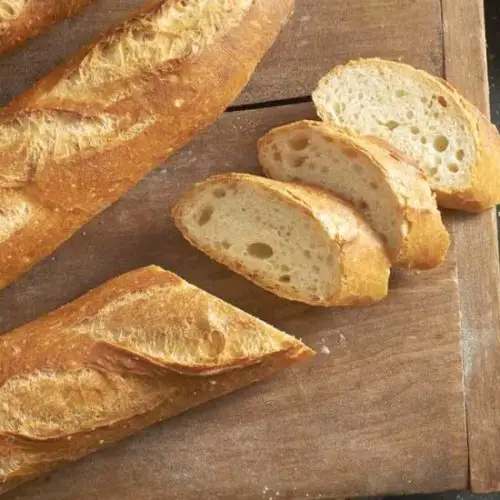
Baguette
Master the art of French baking with this classic baguette recipe featuring a long fermentation poolish starter for rich flavor and a perfect crust. Enjoy crusty, chewy baguettes ideal for sandwiches, snacks, or meals.
Equipment
- 1 Kitchen Scale (for precise measurements)
- 1 Large Mixing Bowl (to mix poolish and dough)
- 1 Stand Mixer with Dough Hook or Bread Machine (for kneading)
- 1 Baker’s Lame or Sharp Knife (for scoring)
- 1 Baking Stone or Baking Sheet (to bake the baguettes)
- 1 Cast Iron Pan (to generate steam during baking)
- 1 Cooling Rack (for cooling bread post-baking)
Ingredients
For the Poolish (Pre-ferment):
- 1 cup 125 g all-purpose unbleached flour
- ½ cup 120 ml water, room temperature
- ⅛ teaspoon active dry yeast
For the Dough:
- 2 ½ cups 310 g all-purpose unbleached flour
- 1 cup 240 ml water, room temperature
- 1 teaspoon active dry yeast
- 2 teaspoons fine sea salt
Instructions
- Prepare the Poolish Starter: In a medium bowl, combine the flour, water, and yeast for the poolish. Stir until you have a loose, sticky batter. Cover the bowl loosely with plastic wrap or a towel and leave it on your countertop overnight or for about 12 to 14 hours. The poolish should become bubbly and rise slightly, developing a rich aroma that forms the flavor base of your baguettes.
- Make the Dough: Add the remaining flour, water, yeast, and salt to the bowl with your poolish. Mix everything together by hand, with a wooden spoon, or in a stand mixer fitted with a dough hook on low speed. Knead for approximately 4 to 5 minutes until the dough forms a slightly tacky but cohesive mass. The surface might be a bit rough but should hold together well.
- First Rise and Fold: Transfer the dough to a lightly oiled bowl and cover it with plastic wrap or a damp cloth. Let it rise at room temperature for about 45 minutes. After this, gently press the dough to deflate it and fold the edges into the center, turning the dough over in the bowl. Cover and let it rise for another 45 minutes until it looks noticeably puffed but not doubled.
- Divide and Rest Dough Portions: Turn the dough out onto a lightly greased work surface. Divide it evenly into three portions. Shape each portion into a rough ball by folding the edges underneath. Cover these balls with lightly oiled plastic wrap or a clean towel and let them rest for 15 to 60 minutes. This rest period relaxes the gluten and makes shaping easier.
- Shape the Baguettes: Take one dough ball and gently press it flat. Fold it nearly in half lengthwise, pressing the edges to seal. Rotate the dough 180 degrees and repeat this folding and pressing process twice more. Then, with the seam side down, roll the dough gently into a 16-inch long cylinder, tapering the ends into classic pointed baguette tips.
- Proof the Shaped Baguettes: Place the shaped baguettes seam side down on a baking sheet lined with parchment paper or on a heavily floured couche. Cover loosely with lightly oiled plastic wrap. Allow the baguettes to rise at room temperature for 45 to 60 minutes, until they feel light and slightly puffy but haven’t doubled in size.
- Prepare Oven and Score: Preheat your oven to 450°F (230°C). Place a cast iron pan or an oven-safe dish on the bottom rack to preheat for steam creation. Just before baking, use a baker’s lame or a very sharp knife angled at 45° to make 3 to 5 long, shallow slashes on the top of each baguette. This scoring allows the bread to expand evenly while baking.
- Bake with Steam: Carefully slide the baguettes into the oven, using a peel or the baking sheet. Pour 1 1/2 cups boiling water into the preheated cast iron pan and immediately close the oven door to trap the steam. Bake for 24 to 28 minutes until the crust is deep golden brown and crisp.
- Cool the Baguettes: Remove the baguettes from the oven and transfer them to a cooling rack. For an extra-crispy crust, you can turn off the oven, slightly open the door, and let the baguettes cool completely inside the oven until both bread and oven reach room temperature.
Notes
- Flour Choice: Using unbleached all-purpose flour closely mimics the protein content typical in French baguette flour, giving ideal texture and flavor. Bread flour is a fine substitute but will yield a slightly firmer dough.
- Yeast Adjustments: For enhanced flavor, reduce the yeast to 1 teaspoon and allow the dough to rise slowly over 3 hours at a cool room temperature (around 68°F), folding once each hour.
- Shaping Tips: Handle the dough gently to preserve air bubbles for a light crumb. Avoid pressing down too hard during shaping.
- Steam Importance: The steam in the oven is crucial to achieving the classic baguette crust—don’t skip adding boiling water or using a preheated pan.
- Storage: Keep leftover baguettes in a paper bag at room temperature overnight or freeze for longer storage. Reheat by warming in the oven before serving.